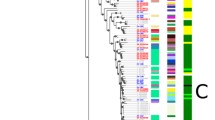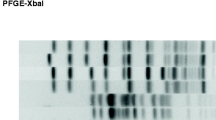Abstract.
The aim of this study was to analyse the results of a programme in the Netherlands for enhanced surveillance of Shiga-toxin-producing Escherichia coli (STEC) O157. In this programme, implemented in January 1999, all laboratories report positive cases to the public health services and submit isolates for typing to the reference laboratory. Public health services collect clinical and risk factor information of patients, using a standardised questionnaire. Results were analysed for the first two and a half years of the programme. In February 2000, a questionnaire was sent to all laboratories to assess (i) the criteria for testing faecal samples for STEC O157, (ii) the diagnostic tools used, and (iii) the level of participation in the surveillance programme. Between January 1999 and June 2001, 93 cases of symptomatic STEC O157 infection were reported, 25% of which occurred in children aged 0–4 years. Serotyping for O, H and stx types showed that two types dominated, O157:H7, stx2 positive (48%) and O157:H–, stx1 and stx2 positive (24%). Analysis of the 93 isolates by pulsed-field gel electrophoresis showed 17 clusters of isolates with at least 95% fragments in common, including isolates with unknown epidemiological links. Of the patients for whom questionnaire information was reported, 38% were hospitalised, 15% developed haemolytic uraemic syndrome, and 52% reported a known risk factor, such as contact with farm animals or manure, consumption of raw or undercooked beef, consumption of raw milk or cheese made from raw milk, or contact with a symptomatic individual. Response to the laboratory survey was high (97%). Only 6% of the laboratories carried out testing for non-O157 STEC, although 95% performed testing for STEC O157. The majority (88%) used culture on sorbitol MacConkey agar or sorbitol MacConkey agar with cefixime and tellurite as the method of detection of STEC O157. The identity of the strains was confirmed primarily with commercially available latex agglutination assays (95% of laboratories) and biochemical characterisation with the API 20E test (bioMérieux, France) (42% of laboratories). Most laboratories (92%) used selection criteria for testing, especially bloody diarrhoea and other clinical information (81% of laboratories) and young age (10%). It is concluded that STEC O157 is a limited public health problem in the Netherlands, although the selective testing policy and the low sensitivity of the culture techniques used probably caused the incidence of STEC O157 infection to be underestimated.
Similar content being viewed by others

Author information
Authors and Affiliations
Additional information
Electronic Publication
Rights and permissions
About this article
Cite this article
van Duynhoven, .Y., de Jager, .C., Heuvelink, .A. et al. Enhanced Laboratory-Based Surveillance of Shiga-Toxin-Producing Escherichia coli O157 in The Netherlands. Eur J Clin Microbiol Infect Dis 21, 513–522 (2002). https://doi.org/10.1007/s10096-002-0756-7
Issue Date:
DOI: https://doi.org/10.1007/s10096-002-0756-7



